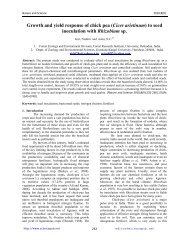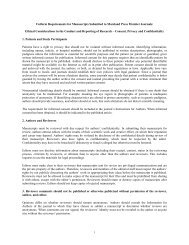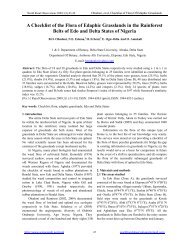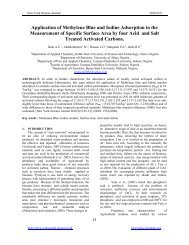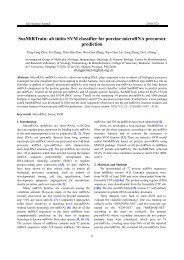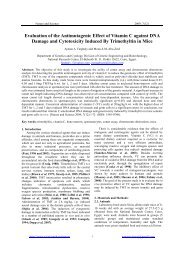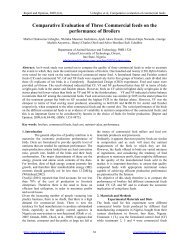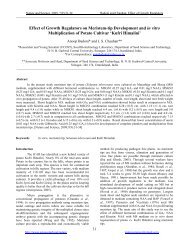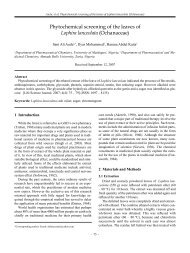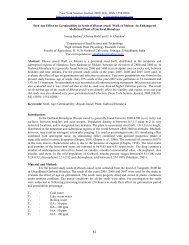Ecological, Social and Commercial Role of Lichens in India with ...
Ecological, Social and Commercial Role of Lichens in India with ...
Ecological, Social and Commercial Role of Lichens in India with ...
You also want an ePaper? Increase the reach of your titles
YUMPU automatically turns print PDFs into web optimized ePapers that Google loves.
Acdemia Arena 2010, Supplement 0201<br />
http://www.sciencepub.net<br />
angiosperms can be effected <strong>and</strong> unable to re-sprout. Kumar (2008) study showed only the ground<br />
or fallen lichen collection should be possible.<br />
In order to improve the socio-economic st<strong>and</strong>ard <strong>of</strong> the people <strong>of</strong> Uttarahk<strong>and</strong>, it may also be<br />
necessary to <strong>in</strong>crease <strong>and</strong> improve the botanical resources <strong>of</strong> the area. Depletion <strong>of</strong> lichen<br />
population is a matter <strong>of</strong> concern from conservation st<strong>and</strong>po<strong>in</strong>t because <strong>of</strong> several reasons; be<strong>in</strong>g<br />
unique symbiotic organisms they contribute to biodiversity; they are ecologically important as<br />
food, shelter <strong>and</strong> nest<strong>in</strong>g materials for a variety <strong>of</strong> wild animals (Mc Cune <strong>and</strong> Geiser 1997).<br />
METERIALS AND METHODS<br />
The Chopta region lies between <strong>and</strong> 30° 30'-30° 42' N latitude <strong>and</strong> 79°-79° 30' E longitude <strong>in</strong><br />
the Garhwal Himalaya is dom<strong>in</strong>ated by Quercus semecarpifolia trees associated <strong>with</strong><br />
Rhododendron spp, Taxus baccata, Abies p<strong>in</strong>drow, Aser spp. <strong>and</strong> Cotoneaster shrub. The dry mass<br />
estimation <strong>of</strong> major lichens from the area on Quercus semecarpifolia <strong>and</strong> Rhododendron arboreum<br />
trees made between 2500m - 3500m above mean sea level. We have identified two purely Q.<br />
semecarpifolia forest at southeast aspect (open canopied forest) <strong>and</strong> northwest aspect (closed<br />
canopied forest) <strong>of</strong> the study area. At presents lichen exploitation has b<strong>and</strong> <strong>in</strong> the study area due to<br />
the area comes under the Kedarnath Wild Life Sanctuary area (KWLS). The study has been carried<br />
out dur<strong>in</strong>g June to September 2006. To assess<strong>in</strong>g the mass <strong>of</strong> major epiphytic lichens vegetation on<br />
three dbh classes trees, we have developed a appropriate methodology. Before collect<strong>in</strong>g the<br />
epiphytic lichen mass, we have provided a reconnaissance survey to collect<strong>in</strong>g the <strong>in</strong>formation on<br />
traditional method <strong>of</strong> lichen harvest<strong>in</strong>g from some high altitude villages <strong>of</strong> district Chamoli.<br />
A. Traditional Method <strong>of</strong> Lichen Harvest<strong>in</strong>g<br />
The method has been traditionally followed by lichen collectors <strong>of</strong> Deval <strong>and</strong> Tharali block <strong>of</strong><br />
Chamoli district <strong>of</strong> Uttrakh<strong>and</strong>. In these areas lichens collected by the villagers or lichen collectors<br />
<strong>of</strong> Ratgawn, Bursol, Dungari, Man, Kolpuri, Mundoli, Vaan, Kul<strong>in</strong>g, Baak <strong>and</strong> Ghes village. This<br />
area comes under the Badr<strong>in</strong>ath forest division. These areas falls <strong>with</strong><strong>in</strong> the Garhwal Himalaya<br />
region <strong>and</strong> the forests are dom<strong>in</strong>ated <strong>with</strong> Quercus semecarpifolia (brown oak) <strong>and</strong> these areas lies<br />
between 2000m to 3000m altitudes <strong>in</strong> west P<strong>in</strong>der range <strong>of</strong> Tharali Tehsil. Brown oak trees <strong>of</strong> the<br />
area harbors luxuriant growth <strong>of</strong> epiphytic lichens. The collectors collects these plants from the<br />
64






